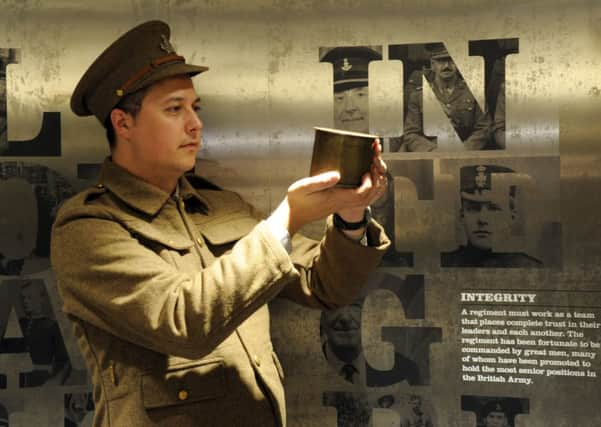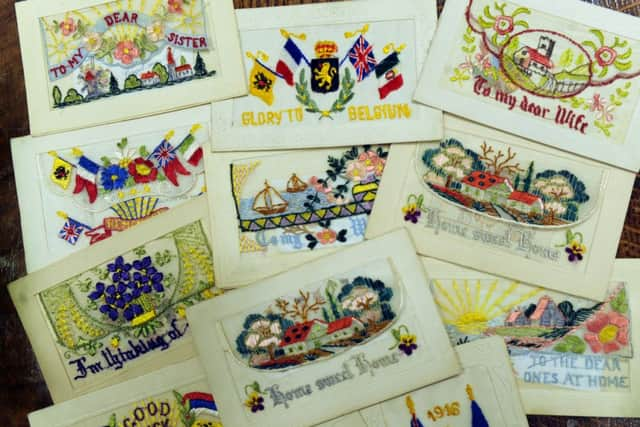The story of a regiment


The first thing visitors will see in Richmond’s new Green Howards Museum is a painting.
Menin Crossroads is the work of Italian First World War artist Fortunino Mantania and it depicts a scene from almost exactly 100 years ago. In the foreground stands Henry Tandey. It’s October 1914 and while he carries a wounded colleague, around him generals and sergeants plan the next move in the bloody Battle of Ypres, which lasted eight weeks and cost the regiment dear. While Tandey survived and went on to become the most highly decorated British private of the First World War, many of those he served alongside never made it back. Even by the end of November 1914 – just four months after war had been declared - the Green Howards had already lost a generation of of young men in Flanders Fields.
Advertisement
Hide AdAdvertisement
Hide Ad“Mantania was known for his realistic portrayal of trench warfare and would take toy soldiers into field hospitals and ask the injured troops to recreate particular battle scenes,” says the museum’s director and curator Lynda Powell. “If you go to this particular spot in Ypres today, it’s largely unchanged. The trees are the same, so is the layout of the houses, but what this painting doesn’t show is that at the end of the crossroads the 16th Bavarian were gathering their forces to attack – it also doesn’t tell you that just two of the men depicted made it through to the end of the war.”


The Green Howards Museum, housed in the Grade I listed Trinity Church, has been a quiet presence on Richmond’s marketplace for decades. However, the museum’s profile is likely to be significantly raised when it reopens to tomorrow following a major revamp. The project has cost £1.7m and and fittingly in this centenary year much of the exhibition space is currently devoted to regiment’s involvement in the First World War.
Between 1914 and 1918 more than 65,000 Yorkshiremen joined their local infantry regiment, serving in the Regular, Territorial and Kitchener’s new army battalions of the Yorkshire Regiment, later renamed the Green Howards. By the end of the conflict 12 Victoria Crosses had been awarded, but 9,000 men had also been killed and 24,000 wounded.
“We really wanted to reopen this year because the museum was born out of the First World War,” says Lynda, who worked as what she calls a “museum doctor”, advising smaller attractions on how best to display their collections before joining the Richmond museum five years ago. “Following the war, soldiers and their families donated hundreds of precious objects to the regiment. They turned up with letters, uniforms and personal mementoes and at first the regiment wasn’t quite sure what to do with them all. However, it seemed right that they were put on display so the museum was created in 1922.”
Advertisement
Hide AdAdvertisement
Hide AdPrior to the revamp, the museum already attracted around 10,000 visitors a year, but the collection was cramped and the lay out a little old fashioned. Over the last year new exhibition spaces have been built, rooms previously off limits to the public have been opened up and they have also injected an interactive element to many of the displays in the hope of encouraging more school parties into the museum.
“The main aim of the project was to make sure the collection was safe,” says Lynda. “It’s not often you get to design a museum from scratch so this has been a real privilege. Hopefully it will allow us to tell the real stories of the Green Howards soldiers and their families through their own diaries, paintings and personal effects.
“It was a very traditional museum. There were items in cases to look at, but that was about it. We have now a great deal more flexibility to introduce new temporary exhibitions and swap the collection around, so hopefully people won’t think that if they’ve been here once there’s no point coming again because everything will be the same. What we wanted to do with this project was to make it a lot more interactive and to really tell the story not just of the regiment, but the people who have served in it.”
Lynda is referring to men like Lieutenant Colonel HB Morkill, whose life story reads like a Boy’s Own adventure. Bored with an early posting in India, during the First World War, Morkill decided he would sign up for the Royal Flying Corps. It turned out that he was something of a natural, learning to fly within just a couple of hours, and having successfully enlisted he brought along a friend.
Advertisement
Hide AdAdvertisement
Hide Ad“He had a pet lemur,” says Lynda, who has now been able to display a number of artefacts relating to Morkill’s career, including his flying goggles. “He kept it in his flying jacket, but apparently he would never take it on really dangerous missions. The history of the Green Howards is full of characters like him and it’s just wonderful to be able to tell their stories. In another room we have an imposing portrait of Colonel Bulfin. He was out in Ypres and his unit suffered so many losses that when the Germans went to advance again, the only people who he could muster to form a line were the regiment’s cooks and drivers. They all duly did what they were told and incredibly managed to push the enemy forces back half a mile.”
The upper level of the museum covers the years between 1688 and 1901, particularly focusing on the Green Howards’ involvement in the Crimean and Boer Wars, while the first floor is home to the medal room and a new display of regimental life in the Officers’ and Sergeants’ Mess.
“There are some incredibly poignant pieces,” says Lynda. “Look at this pin cushion which was made by a soldier injured in the First World War. It was part of his rehabilitation and I guess it was an early form of art therapy. The lighting wasn’t particularly great in the old museum and you really couldn’t see some of the collection properly. Now visitors will be able to see some of our most fragile pieces up close.”
Among them are the Green Howards’ regimental colours which were carried into the Battle of Alma in 1854. Now faded and threadbare, they are an eerie reminder of chapter in history in which just over 2,000 British soldiers lost their lives.
Advertisement
Hide AdAdvertisement
Hide Ad“We know that one of the young soldiers who carried the colours died after being shot in the head,” says Lynda. “Every single piece in this collection tells a story, sometimes that story is tragic, but it’s important that we remember those who served so selflessly.”
In 2004, as part of the re-organisation of the infantry, it was announced that the Green Howards would merge with the Prince of Wales’s Own Regiment of Yorkshire and the Duke of Wellington’s Regiment to form the new Yorkshire Regiment. The official rebadging took place in June 2006, while elements of the regiment were stationed in Bosnia and Kosovo and part of the museum’s aim is to ensure the philosophy and traditions of the original regiment lives on.
“The museum is also the Yorkshire Regiment’s headquarters and we want to feel that we are part of the modern army and not just a museum to a dead regiment. Before we never really had the space to explore what happened after 1945, but now we have displays which take in the Cold War, Northern Ireland, Bosnia and Afghanistan.
“Because they are recent history people tend to think that their kit is not of historical importance, but it absolutely is.”
Advertisement
Hide AdAdvertisement
Hide AdThe idea for the £1.7m revamp began to take shape three years ago. The bulk of the money has come from the Heritage Lottery Fund and has allowed the museum to create an education team which for the last year has been working with schools in the county.
“So far we’ve talked to more than 2,000 school children,” says education manager Liam Beeton, who previously worked at York’s National Railway Museum. “The story of the Green Howards is a fascinating one and we are really blessed that we have so many personal objects that can bring that story to life.”
A couple of weeks before the reopening there was still much to do. Electricians were busy fitting new lighting in the medal room and finishing touches were still being put to many of the displays.
“It’s important that we get it right,” says Lynda, who has no personal connection to the Green Howards but is now fully versed in the regiment’s long history. “Ever since the building work began, we have had people popping in desperate to know when we were going to reopen and hoping for a sneak preview. This museum is important to the town, but it’s also important to the whole of Yorkshire.”
Advertisement
Hide AdAdvertisement
Hide Ad• The Green Howards Museum will officially reopen at 10am on Sunday. On Tuesday, November 11 at 11.30am there will be an opportunity to tour the museum with curator Lynda Powell. Normal admission price applies and the tour will last around an hour. 01748 826561, www.greenhowards.org.uk